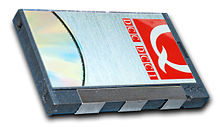This article has multiple issues. Please help improve it or discuss these issues on the talk page. (Learn how and when to remove these messages)
|
 | |
  A Digital Compact Cassette sent to the readers of Q magazine | |
| Media type | Magnetic cassette tape |
|---|---|
| Encoding | Precision Adaptive Sub-band Coding (MPEG-1 Audio Layer I) |
| Capacity | Theoretically 120 minutes; longest available tapes were 105 minutes |
| Write mechanism | Multi-track stationary head |
| Developed by | Philips, Matsushita Electric |
| Usage | Digital audio |
| Extended from | Compact Cassette |
Digital Compact Cassette (DCC) is a magnetic tape sound recording format introduced by Philips and Matsushita Electric in late 1992 and marketed as the successor to the standard analog Compact Cassette. It was also a direct competitor to Sony's MiniDisc (MD), but neither format toppled the then-ubiquitous analog cassette despite their technical superiority, and DCC was discontinued in October 1996. Another competing format, the Digital Audio Tape (DAT), had by 1992 also failed to sell in large quantities to consumers, although it was popular as a professional digital audio storage format.
The DCC form factor is similar to the analog compact cassette (CC), and DCC recorders and players can play back either type: analog as well as DCC. This backward compatibility was intended to allow users to adopt digital recording without rendering their existing tape collections obsolete, but because DCC recorders couldn't record (only play back) analog cassettes, it effectively forced consumers to either replace their cassette deck with a DCC recorder and give up analog recording, or keep the existing cassette deck and make space to add the DCC recorder to their setup.